Quick Look
Grade Level: 4 (3-5)
Time Required: 2 hours 30 minutes
(An hour and 45 min class period and an addition 45 min class period for testing/ iterations.)
Expendable Cost/Group: US $3.00
Group Size: 3
Activity Dependency: None
Subject Areas: Data Analysis and Probability, Earth and Space, Life Science, Measurement, Problem Solving
NGSS Performance Expectations:

| 3-5-ETS1-1 |
| 3-5-ETS1-2 |
| 3-5-ETS1-3 |
| 4-ESS2-1 |
| 4-ESS3-2 |
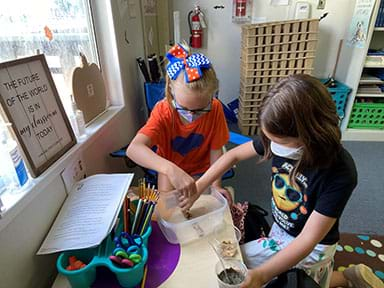
Summary
Preventing coastal erosion and loss of land due to storms is an important component of civil engineering, specifically among coastal engineers. In this activity, students become coastal engineers as they use their knowledge of storm/beach erosion to create seawalls out of recycled materials. In small groups, students use the engineering design process to consider the costs of materials and determine the best way to use their budget and their knowledge of each material to build a seawall to withstand erosion under storm conditions. After they develop their prototype, each team then takes measurements and observations about the effects of weathering upon their simulated beach. Students not only observe the effects of weathering, but they also use their knowledge of rocks and minerals to determine how to best construct their design.Engineering Connection
Civil engineers construct buildings, roads, schools, and many other things we reside in or travel on every day. Coastal engineers are civil engineers who specialize in building near the ocean. They combine civil engineering with oceanography and coastal geology to build structures near the coast to withstand weathering, storms, and the ecological impact of construction. Coastal engineers are constantly improving upon ways to reduce the ecological impact of their builds and decrease the cost of their construction. One of the ways coastal engineers try to do this is by using recycled materials or natural resources sourced from the region around their build.
Learning Objectives
After this activity, students should be able to:
- Identify patterns of change and erosion on the coast by observing maps and diagrams.
- Describe the effect of storm erosion on coasts.
- Apply steps of the engineering design process.
- Create a design that considers specific constraints such as materials, costs, and time to design a seawall that can withstand erosion.
Educational Standards
Each TeachEngineering lesson or activity is correlated to one or more K-12 science,
technology, engineering or math (STEM) educational standards.
All 100,000+ K-12 STEM standards covered in TeachEngineering are collected, maintained and packaged by the Achievement Standards Network (ASN),
a project of D2L (www.achievementstandards.org).
In the ASN, standards are hierarchically structured: first by source; e.g., by state; within source by type; e.g., science or mathematics;
within type by subtype, then by grade, etc.
Each TeachEngineering lesson or activity is correlated to one or more K-12 science, technology, engineering or math (STEM) educational standards.
All 100,000+ K-12 STEM standards covered in TeachEngineering are collected, maintained and packaged by the Achievement Standards Network (ASN), a project of D2L (www.achievementstandards.org).
In the ASN, standards are hierarchically structured: first by source; e.g., by state; within source by type; e.g., science or mathematics; within type by subtype, then by grade, etc.
NGSS: Next Generation Science Standards - Science
| NGSS Performance Expectation | ||
|---|---|---|
|
3-5-ETS1-1. Define a simple design problem reflecting a need or a want that includes specified criteria for success and constraints on materials, time, or cost. (Grades 3 - 5) Do you agree with this alignment? |
||
| Click to view other curriculum aligned to this Performance Expectation | ||
| This activity focuses on the following Three Dimensional Learning aspects of NGSS: | ||
| Science & Engineering Practices | Disciplinary Core Ideas | Crosscutting Concepts |
| Define a simple design problem that can be solved through the development of an object, tool, process, or system and includes several criteria for success and constraints on materials, time, or cost. Alignment agreement: | Possible solutions to a problem are limited by available materials and resources (constraints). The success of a designed solution is determined by considering the desired features of a solution (criteria). Different proposals for solutions can be compared on the basis of how well each one meets the specified criteria for success or how well each takes the constraints into account. Alignment agreement: | |
| NGSS Performance Expectation | ||
|---|---|---|
|
3-5-ETS1-2. Generate and compare multiple possible solutions to a problem based on how well each is likely to meet the criteria and constraints of the problem. (Grades 3 - 5) Do you agree with this alignment? |
||
| Click to view other curriculum aligned to this Performance Expectation | ||
| This activity focuses on the following Three Dimensional Learning aspects of NGSS: | ||
| Science & Engineering Practices | Disciplinary Core Ideas | Crosscutting Concepts |
| Generate and compare multiple solutions to a problem based on how well they meet the criteria and constraints of the design problem. Alignment agreement: | Research on a problem should be carried out before beginning to design a solution. Testing a solution involves investigating how well it performs under a range of likely conditions. Alignment agreement: At whatever stage, communicating with peers about proposed solutions is an important part of the design process, and shared ideas can lead to improved designs.Alignment agreement: | Engineers improve existing technologies or develop new ones to increase their benefits, to decrease known risks, and to meet societal demands. Alignment agreement: |
| NGSS Performance Expectation | ||
|---|---|---|
|
3-5-ETS1-3. Plan and carry out fair tests in which variables are controlled and failure points are considered to identify aspects of a model or prototype that can be improved. (Grades 3 - 5) Do you agree with this alignment? |
||
| Click to view other curriculum aligned to this Performance Expectation | ||
| This activity focuses on the following Three Dimensional Learning aspects of NGSS: | ||
| Science & Engineering Practices | Disciplinary Core Ideas | Crosscutting Concepts |
| Plan and conduct an investigation collaboratively to produce data to serve as the basis for evidence, using fair tests in which variables are controlled and the number of trials considered. Alignment agreement: | Tests are often designed to identify failure points or difficulties, which suggest the elements of the design that need to be improved. Alignment agreement: Different solutions need to be tested in order to determine which of them best solves the problem, given the criteria and the constraints.Alignment agreement: | |
| NGSS Performance Expectation | ||
|---|---|---|
|
4-ESS2-1. Make observations and/or measurements to provide evidence of the effects of weathering or the rate of erosion by water, ice, wind, or vegetation. (Grade 4) Do you agree with this alignment? |
||
| Click to view other curriculum aligned to this Performance Expectation | ||
| This activity focuses on the following Three Dimensional Learning aspects of NGSS: | ||
| Science & Engineering Practices | Disciplinary Core Ideas | Crosscutting Concepts |
| Make observations and/or measurements to produce data to serve as the basis for evidence for an explanation of a phenomenon. Alignment agreement: | Rainfall helps to shape the land and affects the types of living things found in a region. Water, ice, wind, living organisms, and gravity break rocks, soils, and sediments into smaller particles and move them around. Alignment agreement: Living things affect the physical characteristics of their regions.Alignment agreement: | Cause and effect relationships are routinely identified, tested, and used to explain change. Alignment agreement: |
| NGSS Performance Expectation | ||
|---|---|---|
|
4-ESS3-2. Generate and compare multiple solutions to reduce the impacts of natural Earth processes on humans. (Grade 4) Do you agree with this alignment? |
||
| Click to view other curriculum aligned to this Performance Expectation | ||
| This activity focuses on the following Three Dimensional Learning aspects of NGSS: | ||
| Science & Engineering Practices | Disciplinary Core Ideas | Crosscutting Concepts |
| Generate and compare multiple solutions to a problem based on how well they meet the criteria and constraints of the design solution. Alignment agreement: | A variety of hazards result from natural processes (e.g., earthquakes, tsunamis, volcanic eruptions). Humans cannot eliminate the hazards but can take steps to reduce their impacts. Alignment agreement: Testing a solution involves investigating how well it performs under a range of likely conditions.Alignment agreement: | Cause and effect relationships are routinely identified, tested, and used to explain change. Alignment agreement: Engineers improve existing technologies or develop new ones to increase their benefits, to decrease known risks, and to meet societal demands.Alignment agreement: |
Common Core State Standards - Math
-
Attend to precision.
(Grades
K -
12)
More Details
Do you agree with this alignment?
-
Reason abstractly and quantitatively.
(Grades
K -
12)
More Details
Do you agree with this alignment?
-
Represent and interpret data.
(Grade
4)
More Details
Do you agree with this alignment?
-
Fluently add and subtract multi-digit whole numbers using the standard algorithm.
(Grade
4)
More Details
Do you agree with this alignment?
-
Fluently multiply multi-digit whole numbers using the standard algorithm.
(Grade
5)
More Details
Do you agree with this alignment?
International Technology and Engineering Educators Association - Technology
-
Apply the technology and engineering design process.
(Grades
3 -
5)
More Details
Do you agree with this alignment?
-
Evaluate designs based on criteria, constraints, and standards.
(Grades
3 -
5)
More Details
Do you agree with this alignment?
-
Practice successful design skills.
(Grades
3 -
5)
More Details
Do you agree with this alignment?
State Standards
Florida - Math
-
Attend to precision.
(Grades
K -
12)
More Details
Do you agree with this alignment?
-
Reason abstractly and quantitatively.
(Grades
K -
12)
More Details
Do you agree with this alignment?
-
Fluently add and subtract multi-digit whole numbers using the standard algorithm.
(Grade
4)
More Details
Do you agree with this alignment?
-
Fluently multiply multi-digit whole numbers using the standard algorithm.
(Grade
5)
More Details
Do you agree with this alignment?
Florida - Science
-
Identify that wind and water cause physical weathering and erosion of rocks.
(Grade
4)
More Details
Do you agree with this alignment?
-
Describe the basic differences between physical weathering (breaking down of rock by wind, water, ice, temperature change, and plants) and erosion (movement of rock by gravity, wind, water, and ice).
(Grade
4)
More Details
Do you agree with this alignment?
Materials List
Each group needs:
- 2 clear containers (6qt) per group (https://www.homedepot.com/p/Sterilite-6-Qt-Storage-Box-16426A60/308820126#overlay)
- measuring cup (1-cup or 2-cup)
- 12 cups sand
- 12 cups water
- Cost Benefit Analysis Worksheet
- Engineering a Seawall Rubric
For the entire class to share:
- pea gravel - 50 lb. bag (available online or you can pick up gravel from local areas and students can measure it out from a container as needed)
- Quikrete - 50 lb. bag, premixed into 5 oz. cups for students to “purchase” (available online or in home improvement stores)
- paper cups (5 oz.)
- Popsicle sticks
- recycled rubber/rubber chips (available online or in a school playground)
- spoons
- 2-3 digital scales to weigh materials
- laptop and projector to share the Coastal Erosion PowerPoint Presentation
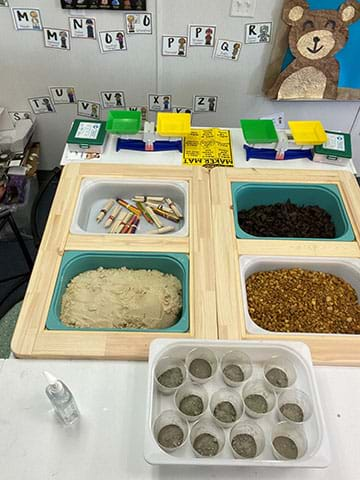
Worksheets and Attachments
Visit [www.teachengineering.org/activities/view/uof-2630-engineering-seawall-storm-erosion-activity] to print or download.Pre-Req Knowledge
Understand different types of weathering.
Understand the effects of weathering upon the earth.
Have the ability to measure.
Be able to do multiple digit addition and subtraction.
Have a basic understanding of money.
Introduction/Motivation
Recently a local storm came through and eroded the beach at St. Augustine, FL. Students will no longer be able to visit the beach for their field trip due to the beach erosion!
What do we know about erosion? (Let students offer their thoughts and ideas. Answer: Erosion is the wearing away of the surface of the Earth by natural processes such as weathering, dissolution, abrasion, corrosion. Different types of erosion include chemical, water, wind, glacier, and temperature.) How does erosion affect us where we live? Where can we see the effects of erosion? (Ask students these questions or have them think-pair share; after students have given some answers, show the video of coastal erosion: https://www.youtube.com/watch?v=ypNrtde57vk)
Ask students to describe what they observed. What was the cause of the erosion in this video? How long did it take for the beach to erode? What problems could you see the erosion causing? How much did they say it would cost to rebuild the coast? Finally, ask the students “What solutions do we have to stop something like this from happening?” Today we will be trying to solve this problem in our classroom just like coastal engineers do every day. We know that engineers love to use recycled or natural materials as much as possible so that is what we will be attempting to do as well.
Your goal is to use the steps of the engineering design process to create a wall that prevents erosion while also having the lowest cost and impact on the environment. You will have the option of making a wall out of recycled concrete, rubber, or mangroves. Out of those three materials, what do you think is the most environmentally friendly? Why? You will each have a budget of $50 dollars to spend. You can spend all of it and have the strongest design, but you also must take into consideration the environmental impact. Certain materials will give you positive environmental impact points and other materials will give you negative points. You will also lose or gain points depending on how much sand erodes after each storm.
Work with your group to determine what materials you will use and how much you will need of each of them. Then decide what shape your seawall will be. After you have worked out how much this will all cost you, you can come to me to get your budget approved and then measure out your materials. After you have built your wall and it is dry, we will test it out under storm conditions 3 times. Each time we will record how much sand washes away from behind the wall. Then, we will see how we can improve upon our first designs.
Procedure
Background
How does coastal erosion work? Coastal erosion can happen gradually over time just like any other type of erosion, but it can also occur rapidly when a large storm occurs near or on the coast. Storms can take away meters of coastline overnight. While this is a naturally occurring phenomena, people tend to build along the ocean. This leaves manmade structures nearby at risk.
Coastal engineers try to combat this rapid erosion in several ways. They work on shore restoration, dredging up sand from the ocean to replenish the beach. When they can, they use natural plants from the area such as mangroves to create natural barriers along the shoreline. The most effective method that coastal engineers currently have is to build seawalls. Seawalls work to reflect, absorb, or deflect the energy of storm surge waves from the sand or earth. While seawalls are the best option, they are not necessarily the most environmentally friendly option. To help combat their environmental impact, many engineers have begun to utilize recycled materials such as concrete or rubber in their build. This not only reduces their impact, but also their cost. Engineers have also designed different seawall shapes that are more appropriate for the types of storm surges that an area experience. After all, a tsunami is very different than a hurricane. All these factor and considerations a necessary for coastal engineers to consider while doing their jobs.
Before the Activity
- Gather materials
- Make copies of the Cost Benefit Analysis Worksheet. (One packet per group.)
- Set up scales
- Have Quikrete premixed according to instructions on bag. Do not add water poured in because it dries quickly but have a measured amount of powder in each cup with a spoon.
- Have the Coastal Erosion PowerPoint Presentation ready on board.
With the Students
Day 1
- Review with the class the seven basic steps of the engineering design process and write the process on the board as each step is discussed. Start by drawing an arrow in the shape of a circle or use a digital graphic from the Engineering Design Process page.
- Have students gather in circle or on carpet. Bring up slide 2 and have students talk in pairs about the three questions. After, ask for a few volunteers for answers to each question.
- Show the video on slide 3.
- Have students turn and share again and discuss questions on slide 4.
- Tell the students that the beach at St. Augustine where we are having our field trip is having a problem with erosion, because of this we might not be able to visit the beach on our field trip. Ask them what we could do as engineers to make sure there is a beach for us to visit when we go later this year.
- After students come up with the answer of a seawall and other shoreline protection options, ask what types of seawalls there are and then show slide 5.
- Ask students what the costs and benefits of each shape are.
- Ask students what kind of environmental impact they think seawalls have on the shoreline and what they could do to reduce that impact, but also keep our shoreline from shrinking.
- Remind students of their engineering challenge and identify the engineering criteria and constraints. They are tasked with designing a seawall using the available materials that minimizes the environmental impact and cost while ensuring the shore stays safe from surge waves.
- From here, show students the Cost Benefit Analysis Worksheet and then tell them these instructions (they can also be found on slide 10-11):
- Brainstorm with your group which material you think you want to use.
- Take measurements of your container and estimate how much material you will need to purchase. You must also think of what type of seawall you are creating: mound, vertical or curved. Imagine possible solutions with your group.
- Take each group member’s design into consideration and plan by selecting one promising solution considering the design constraints. Record choices on Design page on the Cost Benefit Analysis Worksheet.
- Before purchasing, fill out the cost benefit analysis. Determine the total cost of your first seawall iteration and the environmental impact.
- Once you have filled out your paper you can bring it to the store to purchase materials.
- It is time to create and build your prototype! Work as a team and use your materials wisely! If you need more materials add them to your ledger and then go to the store.
- When you are finished, put your wall on table to dry and fill out your predictions sheet.
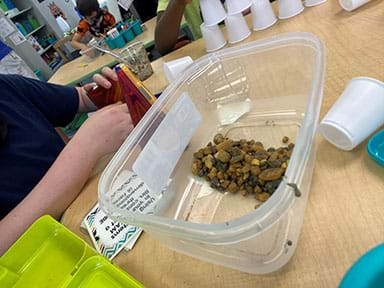
- As students are doing their work, circulate around the room and facilitate their thought process by asking open ended questions. Try to have them explain their thought process behind certain choices.
- If there is time, do your first round of testing on the first day.
- First model how to fill the containers to the students and draw the slope. Do one round as an example and then let them test independently. Here are instructions for students:
- Fill your container with the correct amount of sand on one side of the wall and correct amount of water on the other side.
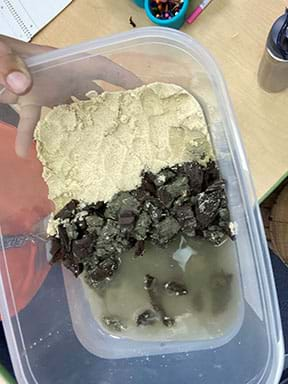
A student’s seawall design ready for testing. - Trace the slope of the sand in your container on the side of the container in permanent marker. Test the slope by gently shaking the container.
- After the test, record your change in slope on the side by tracing it with a different colored marker. Measure the change in the slope at the greatest point of difference in centimeters. Record it on your sheet.
- Reset your container and repeat these steps two more times.
- Once finished, record your findings and brainstorm with team for what could be done better.
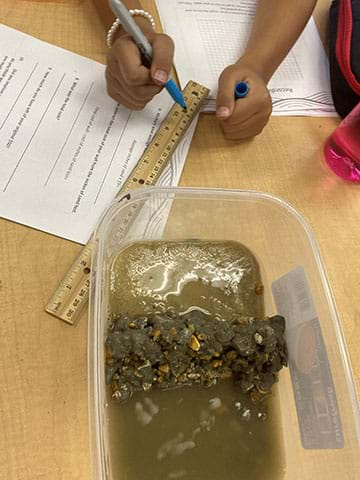
A student’s seawall design after testing.
Day 2
- Same materials preparations as Day 1.
- On Day 2 have students brainstorm how to improve their design. Repeat the steps of Day 1. Explain that engineers are constantly working to improve their design. They test and iterate to make their design the best it can be.
- Once students have finished and recorded all their data, finish the activity with the discussion questions on slide 12 and have students present their data as well.
Vocabulary/Definitions
beach nourishment: Lacing additional sand on a beach to serve as a buffer against erosion or to enhance the recreational value of the beach.
civil engineer: An engineer who designs and maintains roads, bridges, dams, and similar structures.
coastal engineering: A division of civil engineering responsible for the organization, conception, development, and preservation of works on the shoreline.
coastal erosion: A loss or displacement of land, or the long-term removal of sediment and rocks along the coastline due to the action of waves, currents, tides, wind-driven water, waterborne ice, or other impacts of storms.
erosion: Wearing away of the surface of the Earth by natural processes (weathering, dissolution, abrasion, corrosion, etc.); types of erosion include chemical, water, wind, glacier, and temperature.
mangroves: A tree or shrub that grows in chiefly tropical coastal swamps that are flooded at high tide. Mangroves typically have numerous tangled roots above ground and form dense thickets.
natural resources: Materials or substances such as minerals, forests, water, and fertile land that occur in nature and can be used for economic gain.
recycled materials: A material that has been recovered or diverted from the non- hazardous solid waste stream for purpose of reuse, recycling, or reclamation and a substantial. portion of which is consistently used in the manufacture of products, which may otherwise be. produced using raw or virgin materials.
seawall: A wall or embankment erected to prevent the sea from encroaching on or eroding an area of land.
sediment: A material that settles to the bottom of a liquid.
weathering: A gradual physical and chemical wearing a way of rocks.
Assessment
Pre-Activity Assessment
Discussion: Students will think-pair share what they know about erosion and its effects. They will be asked to formulate possibilities for the question “How could a building near the ocean be affected by erosion?” We will then share our answers with the group.
Activity Embedded (Formative) Assessment
Cost Benefit Analysis: Students will use the Cost Benefit Analysis Worksheet to determine which material would be best to use given their budget restraints.
Recording Sheet: As they do each iteration, students will record how much sand has eroded away and any other damage they may notice on the Cost Benefit Analysis Worksheet.
Diagram Drawing: Groups will draw a diagram/ initial plan laying out their wall and its shape.
Post-Activity (Summative) Assessment
Post-Activity Presentation/ Discussion: Students will show the results of their experiment either with pictures/ drawings or a model and explain the reasoning for their designs as well as what they could have done better. They will discuss if they could have reduced the cost or used a better material or designed their wall shape differently etc.
Investigating Questions
- What do we know about erosion?
- How does erosion affect us where we live?
- Where can we see the effects of erosion?
- Why do engineers have to consider the environment in design
Activity Extensions
After you explore coastal erosion take a look at the events that led to the dustbowl in the 1930’s and the erosion that happened then due to environmental factors or have your students look into the other effects that large storms such as hurricanes have on their environment. You could also have them write a PSA with suggestions for how to protect the coast based on what they learned. There are a thousand different directions to go with this! If you want, do more iterations, and add in different factors such as wind.
Activity Scaling
- For lower grades, have student just build each type of wall and choose a shape. Do not involve the Cost Benefit Analysis Worksheet. Have student write down observations about each material used.
- For younger students, have the walls prebuilt. Students can play with the levels of sand and how that affects the wall’s effectiveness.
- For upper grades, students could be given more material options and different storm levels or sand levels they could calculate and predict their wall’s response after each iteration.
- For older students, students could be given more material options and different storm levels or sand levels they could calculate and predict their wall’s response after each iteration.
- For more advanced students, more material options and different storm levels or sand levels could be given so they could calculate and predict their wall’s response after each iteration.
Additional Multimedia Support
- The teacher will need a projector or a way of sharing the PowerPoint with the students if they want to use it.
Websites//Research
- Timelapse-Google earth - https://earthengine.google.com/timelapse/
- Beach Erosion Facts for Kids - https://kids.kiddle.co/Beach_erosion
- Shoreline Erosion - https://www.onegeology.org/archive/extra/kids/english/earthProcesses/weathering.html
- Keeping up with Coastal Erosion - https://www.scholastic.com/teachers/teaching-tools/articles.html
- Erosion Facts for Kids - https://www.coolkidfacts.com/erosion-facts/
- Earth Science for kids: Erosion - https://www.ducksters.com/science/earth_science/erosion.php
- Seawall Facts for Kids - https://kids.kiddle.co/Seawall
- The best materials for seawalls - https://sciencing.com/materials-seawalls-8673099.html
- How to build a seawall - https://www.wikihow.com/Build-a-Seawall
Videos
- Coastlines-Coastal Erosion - https://www.bbc.co.uk/bitesize/topics/zvmgvwx/articles/z7rwdp3
- How Coastal Erosion Works - https://www.youtube.com/watch?v=B08iDMXYtR8
- Coastal Engineer - https://www.youtube.com/watch?v=3Ndr9-kNWLo
- Wave testing facilities in Germany - https://www.youtube.com/watch?v=AjaioEX1OBU
Subscribe
Get the inside scoop on all things TeachEngineering such as new site features, curriculum updates, video releases, and more by signing up for our newsletter!More Curriculum Like This

Students are introduced to the primary types of erosion—chemical, water, wind, glacier and temperature. Students investigate examples of each erosion type and discuss how erosion changes the surface of the Earth.
References
National Data Buoy Center. Last modified May 10, 2015. Center of Excellence in Marine Technology,
NOAA. Accessed September 15, 2016. (Source of much teacher background information; also, excellent
interactive map of buoy locations around the world) http://www.ndbc.noaa.gov/
Copyright
© 2021 by Regents of the University of Colorado; original © 2021 University of FloridaContributors
Rebecca ButlerSupporting Program
Multidisciplinary Research Experiences for Teachers of Elementary Grades, Herbert Wertheim College of Engineering, University of FloridaAcknowledgements
This curriculum was based upon work supported by the National Science Foundation under RET grant no. EEC 1711543— Engineering for Biology: Multidisciplinary Research Experiences for Teachers in Elementary Grades (MRET) through the College of Engineering at the University of Florida. Any opinions, findings, and conclusions or recommendations expressed in this material are those of the authors and do not necessarily reflect the views of the National Science Foundation.
Last modified: August 11, 2022







User Comments & Tips